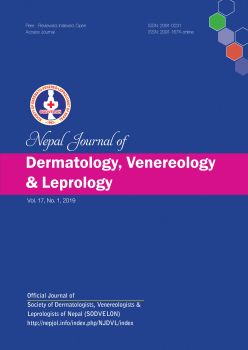Clinico-epidemiological Profile of Women with Non-venereal Vulval Diseases: A Hospital-based Observational Study
DOI:
https://doi.org/10.3126/njdvl.v17i1.23250Keywords:
Lichen Sclerosus et Atrophicus, Pruritus Vulvae, VulvodyniaAbstract
Intorduction: Vulval disorders can be of venereal and non-venereal etiology. Establishing non-venereal causation of vulval disorder helps in alleviating fears in patients with the condition. These patients are better dealt in a multidisciplinary clinic as patients with these disorders frequently visit dermatologists and gynecologists for the treatment.
Objectives: To study the clinico-demographic profile of women with non-venereal vulval disorders and to determine their relative frequency.
Materials and Methods: This is an observational, descriptive study done at the Departments of Dermatology and Venereology and Gynecology and Obstetrics, Nepal Medical College Teaching Hospital. All consenting female patients with problems pertaining to female external genitalia were recruited for the study after excluding venereal diseases. Details of the patients were obtained and entered in a predesigned proforma.
Results: Seventy-five females were recruited during a period of 20 months with a mean age of 34.79±17.90 years. Majority were married, uneducated and homemakers. Duration of disease ranged from 3 days to 35 years. Itching was the commonest presenting complaint (82.67%) followed by redness (32.00%), burning sensation (26.67%), white lesions (24.00%) and pain (24.00%). Commonest diagnosis was lichen sclerosus (17.33%), followed by candidiasis (14.67%). Patients presenting with vulval symptoms without lesions were diagnosed with non-specific vulval pruritus (9.33%) and vulvodynia (2.67%).
Conclusion: Itching is the most common presenting complaint and contrary to the popular belief, inflammatory disorders especially lichen sclerosus, rather than infections were common diagnoses in females with non-venereal vulval disorders.
Downloads
Downloads
Published
How to Cite
Issue
Section
License
Copyright on any research article is transferred in full to Nepal Journal of Dermatology, Venereology & Leprology upon publication. The copyright transfer includes the right to reproduce and distribute the article in any form of reproduction (printing, electronic media or any other form).




